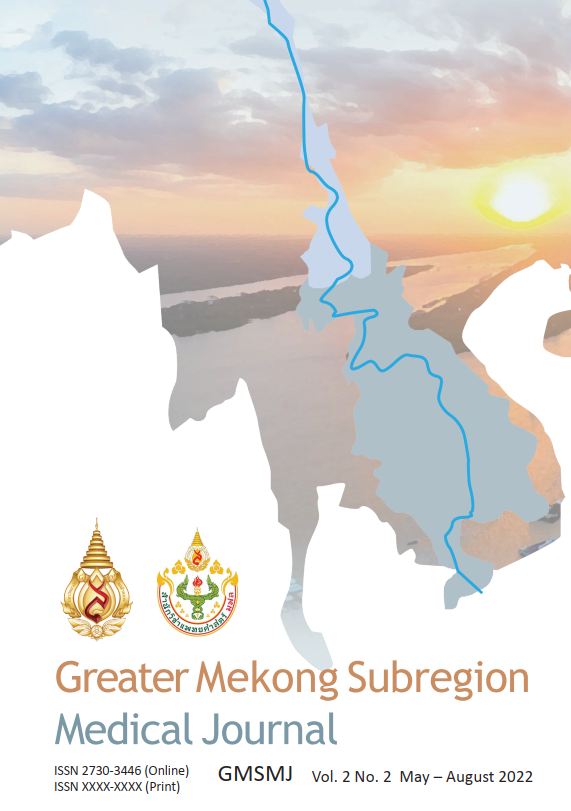Antibody Immune Response Compared between Recombinant Viral Vector and mRNA Vaccines among Health Care Personnel Who Had Previously Received 2 Doses of Inactivated COVID-19 Vaccine
Keywords:
COVID-19 vaccine, AstraZeneca, Pfizer, anti-SARS-CoV-2-SAbstract
Background: Currently, a booster dose of AstraZeneca or Pfizer vaccine was introduced to healthcare personnel who had previously received two doses of inactivated vaccine.
Objective: To compare immune response and rate of adverse reactions after the third dose of AstraZeneca or Pfizer vaccines among healthcare personnel who had already received two doses of inactivated vaccine. We also determined immune response in those who received 2 doses of AstraZeneca vaccine.
Methods: We conducted an observational study at the Mae Fah Luang University Medical Center Hospital. We recruited healthcare personnel who had received AstraZeneca or Pfizer vaccine after 2 doses of Sinovac or received 2 doses of AstraZeneca vaccine. Those who were immunocompromised or had a history of COVID-19 infection were excluded. Participants were divided into 3 groups: (1) Sinovac-Sinovac-AstraZeneca, (2) Sinovac-Sinovac-Pfizer and (3) AstraZeneca-AstraZeneca. Immunoassay for anti-SARS-CoV-2 Spike protein (S) were performed at 30-60 days after the last vaccination dose. Adverse reactions after the third dose of vaccination were collected by using a questionnaire. We performed Kruskal Wallis test to compare antibody titer levels among the 3 groups. Comparisons of adverse reactions between group 1 and group 2 were analyzed using Chi-square or Fisher Exact test for categorical data as appropriate.
Results: There were 50, 111 and 18 participants of group 1, 2 and 3, respectively. All exhibited high titer levels of anti-SARS-CoV-2-S. The average antibody titer levels were highest in group 2 (p < 0.001), following by group 1 and group 3, respectively. Participants of group 1 reported fever and headache more frequently than those of group 2 (p < 0.001).
Conclusion: Current vaccination regimens, booster AstraZeneca or Pfizer vaccine after two doses of inactivated vaccine and 2 doses of AstraZeneca are efficacious in producing immunity against SARS-CoV-2.
References
Corona Virus Disease (COVID-19). Thailand situation. [website on the Internet]. Department of Disease Control, Ministry of Public Health, [cited 2021 Nov 10]. Available from: https://ddc.moph.go.th/viralpneumonia/eng/index.php
Department of Disease Control, Ministry of Public Health. Thailand’s COVID-19 vaccine guidelines for 2021 pandemic situation. The second revision. Bangkok: TS Interprint Company; 2021. Available from: https://ddc.moph.go.th/vaccinecovid19/getFiles/11/1628849610213.pdf
FDA Updates Emergency Use Authorization for COVID-19 Convalescent Plasma to Reflect New Data. 2021 [cited 2021 Aug 14]. Available from: https://www.fda.gov/media/141477/download
Zhang J, He Q, An C, Mao Q, Gao F, Bian L, et al. Boosting with heterologous vaccines effectively improves protective immune responses of the inactivated SARS-CoV-2 vaccine. Emerg Microbes Infect. 2021; 10 (1): 1598-608.
Hillus D, Schwarz T, Tober-Lau P, Vanshylla K, Hastor H, Thibeault C, et al. Safety, reactogenicity, and immunogenicity of homologous and heterologous prime-boost immunisation with ChAdOx1 nCoV-19 and BNT162b2: a prospective cohort study. Lancet Respir Med. 2021; 9 (11): 1255-65.
Keskin AU, Bolukcu S, Ciragil P, Topkaya AE. SARS-CoV-2 specific antibody responses after third CoronaVac or BNT162b2 vaccine following two-dose CoronaVac vaccine regimen. J Med Virol. 2022; 94 (1): 39-41.
Flaxman A, Marchevsky NG, Jenkin D, Aboagye J, Aley PK, Angus B, et al. Reactogenicity and immunogenicity after a late second dose or a third dose of ChAdOx1 nCoV-19 in the UK: a substudy of two randomised controlled trials (COV001 and COV002). Lancet. 2021; 398 (10304): 981-90.
Voysey M, Costa Clemens SA, Madhi SA, Weckx LY, Folegatti PM, Aley PK, et al. Single-dose administration and the influence of the timing of the booster dose on immunogenicity and efficacy of ChAdOx1 nCoV-19 (AZD1222) vaccine: a pooled analysis of four randomised trials. Lancet. 2021; 397 (10277): 881-91.
B. Meyer, G. Torriani, S. Yerly, L. Mazza, A. Calame, I. Arm-Vernez, G. et al. Validation of a commercially available SARS-CoV-2 serological immunoassay. Clin Microbiol Infect. 2020; 26 (10): 1386-94.
Interim Guidelines for COVID-19 Antibody Testing [website on the internet]. Center of Disease Control and Prevention, [updated 2021 Sep 21; cited 2021 Aug 14]. Available from: https://www.cdc.gov/coronavirus/2019-ncov/lab/resources/antibodytests-guidelines.html
Downloads
Published
How to Cite
Issue
Section
License
Copyright (c) 2022 Greater Mekong Sub-region Medical Journal

This work is licensed under a Creative Commons Attribution-NonCommercial 4.0 International License.






